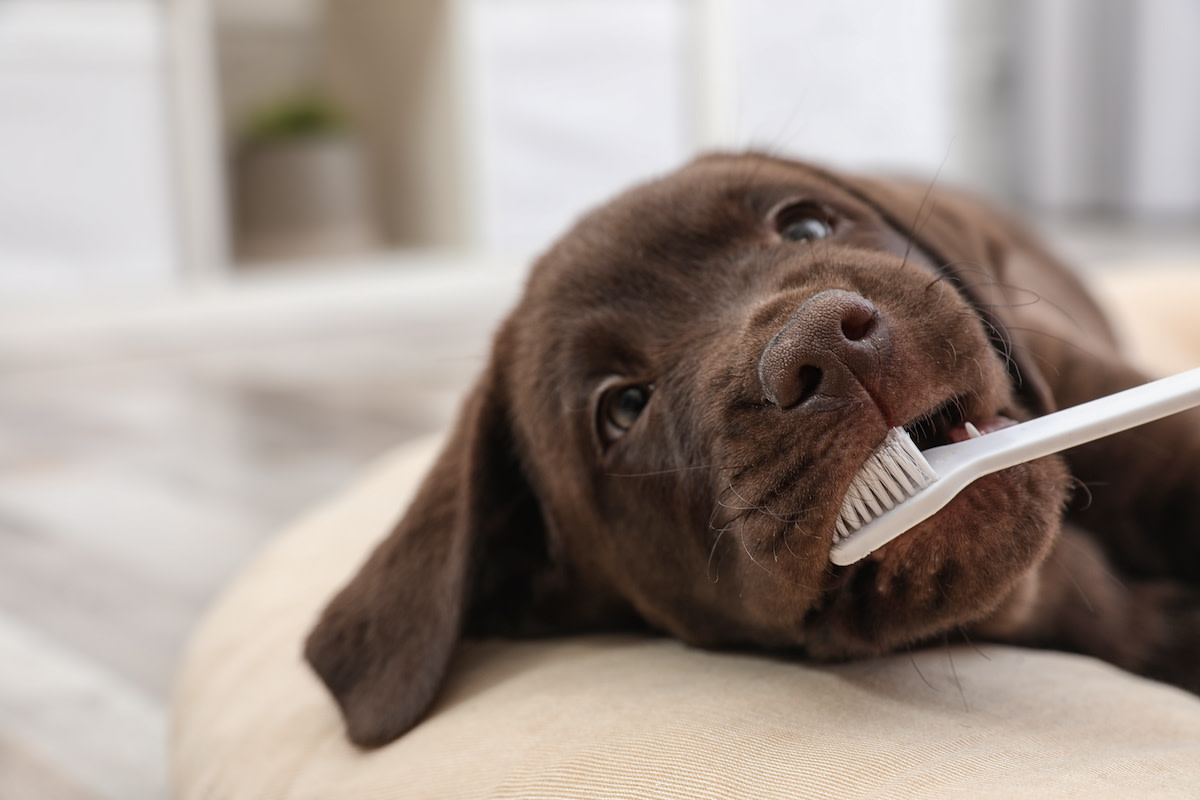How to Brush a Dog’s Teeth: Tips for Brushing a Dog’s Teeth
Written by MasterClass
Last updated: Jan 6, 2022 • 4 min read
Approximately two out of every three dogs suffer from periodontal disease after the age of three. Learning how to brush a dog’s teeth is imperative to their dental health, which can impact their overall health.
Learn From the Best
How Often Should You Brush a Dog’s Teeth?
Pet parents should ideally give their dog’s teeth a daily brushing. Just like humans, dogs develop plaque buildup and tartar buildup on their teeth without routine oral care. At the very least, brush your dog’s teeth once a week.
Regular brushing can improve your dog’s oral health and prevent gum disease and bad breath. If you can’t get your dog to sit still that frequently or they resist dental cleanings, try other methods in between cleanings, such as dental wipes or dog treats, that clean their teeth.
How to Brush a Dog’s Teeth
Once your dog is familiar with your hands around their mouth, you can try brushing their teeth. Follow these steps on how to brush your dog’s teeth:
- 1. Get in a comfortable position. Pick a quiet area free of distractions and get in a position that is comfortable for both you and the dog. Depending on how large your dog is, you may choose to sit on a chair across from your pet (if you have a large dog) or have them sit in your lap with their head facing away from you (if you have a smaller dog). Wrap small dogs in a towel to help soothe them and keep them still during the brushing process.
- 2. Start by brushing with your fingers. Wrap your finger in medical gauze for extra protection. Apply dog toothpaste to your finger, then use that free hand to lift the dog’s lip. Next, apply the product to the outside of your dog’s teeth, right at the gum line along the sides. Aim for a few seconds on each side to start, working gently in small circles. After a few days or weeks of doing this, you can graduate to using a toothbrush.
- 3. Collect the right tools for the job. Some dog toothbrushes are designed to fit around your finger (perfect for dogs under thirty pounds) while others are full-sized with soft bristles and long handles (ideal for larger dogs). Choose the most suitable option for you and your pet. At the pet store, you’ll find an array of doggy toothpaste options, flavored and unflavored, that you can use for the job. Avoid using human toothpaste because they often contain an artificial sweetener, which is toxic to dogs.
- 4. Brush at an angle. Apply the dog toothpaste to the toothbrush. Hold the brush at a forty-five-degree angle against the dog’s gum line and repeat the same small circular motions you made with your finger. Gradually increase the amount of time you spend on each side (thirty seconds for both), starting at the back teeth and working your way to the middle.
- 5. Keep a routine. Try to work your dog’s dental cleanings into a daily routine. Consistency trains your dog to be more comfortable and with the situation.
- 6. Reward your dog. After each teeth-brushing session, reward your dog with a healthy treat, like dental chews that fight plaque, or positive reinforcement to let them know they’ve done a good job. A positive experience for both of you will make the process much easier going forward.
4 Tips for Brushing a Dog’s Teeth
The following tips can make the canine dental care experience easier and more enjoyable for both dog parent and dog:
- 1. Make your dog comfortable. If you’re brushing an unfamiliar dog’s teeth (or brushing your dog’s teeth for the first time), it’s not safe to simply stick your hands in their mouths. Incorporate dog training methods designed to get your dog comfortable with having your hands around their mouths. For example, let your dog lick treats like peanut butter off of your fingers. Start lifting their lips and touching their gums, then rewarding them with positive reinforcement like treats when they let you.
- 2. Pay attention to body language. Closely monitor any changes in your dog’s reactions or behavior when you’re trying to prepare them for tooth brushing. If your dog suddenly feels uncomfortable with your fingers in their mouth, remove your hands and back away. Never shove your hands in a dog’s mouth, especially if they seem distressed, afraid, or aggressive.
- 3. Use dental supplements. Give your dog dental supplements between brushings to maintain upkeep. Water additives, dental chews, wipes, or dental treats can help clean your dog’s mouth and keep their gums healthy. However, brushing their teeth directly is the best way to maintain your dog’s dental health. Avoid using baking soda or other human ingredients that can upset their stomach.
- 4. Use pet toothpaste. Dogs do not understand when to spit, and they will likely try to swallow human toothpaste, which contains ingredients like fluoride and xylitol that are harmful to pets. Only use approved dog-approved toothpaste and toothbrushes to clean your dog’s mouth.
Want to Learn More About Training the Goodest Boy or Girl?
Your dream of having a dog who understands words like “sit,” “stay,” “down,” and—crucially— “no” is just a MasterClass Annual Membership away. The only things you’ll need to train up a well-behaved pup are your laptop, a big bag of treats, and our exclusive instructional videos from superstar animal trainer Brandon McMillan.
